Mental Health Case Study: Assessment of Scott's Condition and Risks
VerifiedAdded on 2020/03/23
|14
|3542
|71
Case Study
AI Summary
This case study presents a detailed analysis of Scott, a 21-year-old male exhibiting signs of acute depression, social withdrawal, and potential self-destructive behaviors. The report examines Scott's condition, including his appearance, behavior, speech, mood, and thought processes, to assess his mental health status. It identifies potential risks, such as drug use, paranoid personality disorder, and suicidal tendencies, and outlines crucial nursing interventions to manage these risks. These interventions emphasize the importance of a safe environment, medication management, talk therapies, and building a therapeutic relationship with the patient. The study also highlights the need for continuous supervision, collaborative care, and education about the patient's condition to ensure his safety and well-being. This case study provides a comprehensive overview of Scott's situation and the necessary steps for effective mental health care.
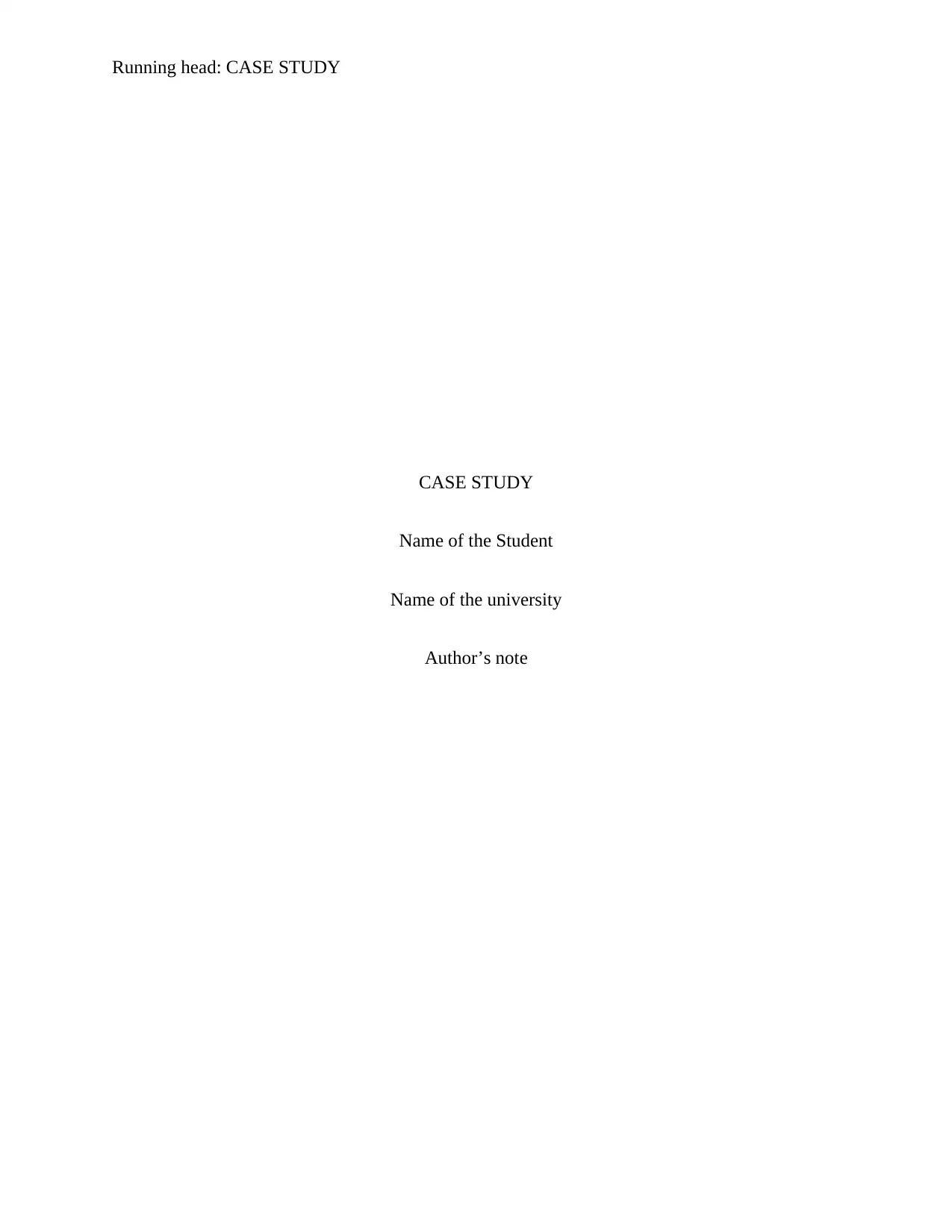
Running head: CASE STUDY
CASE STUDY
Name of the Student
Name of the university
Author’s note
CASE STUDY
Name of the Student
Name of the university
Author’s note
Paraphrase This Document
Need a fresh take? Get an instant paraphrase of this document with our AI Paraphraser
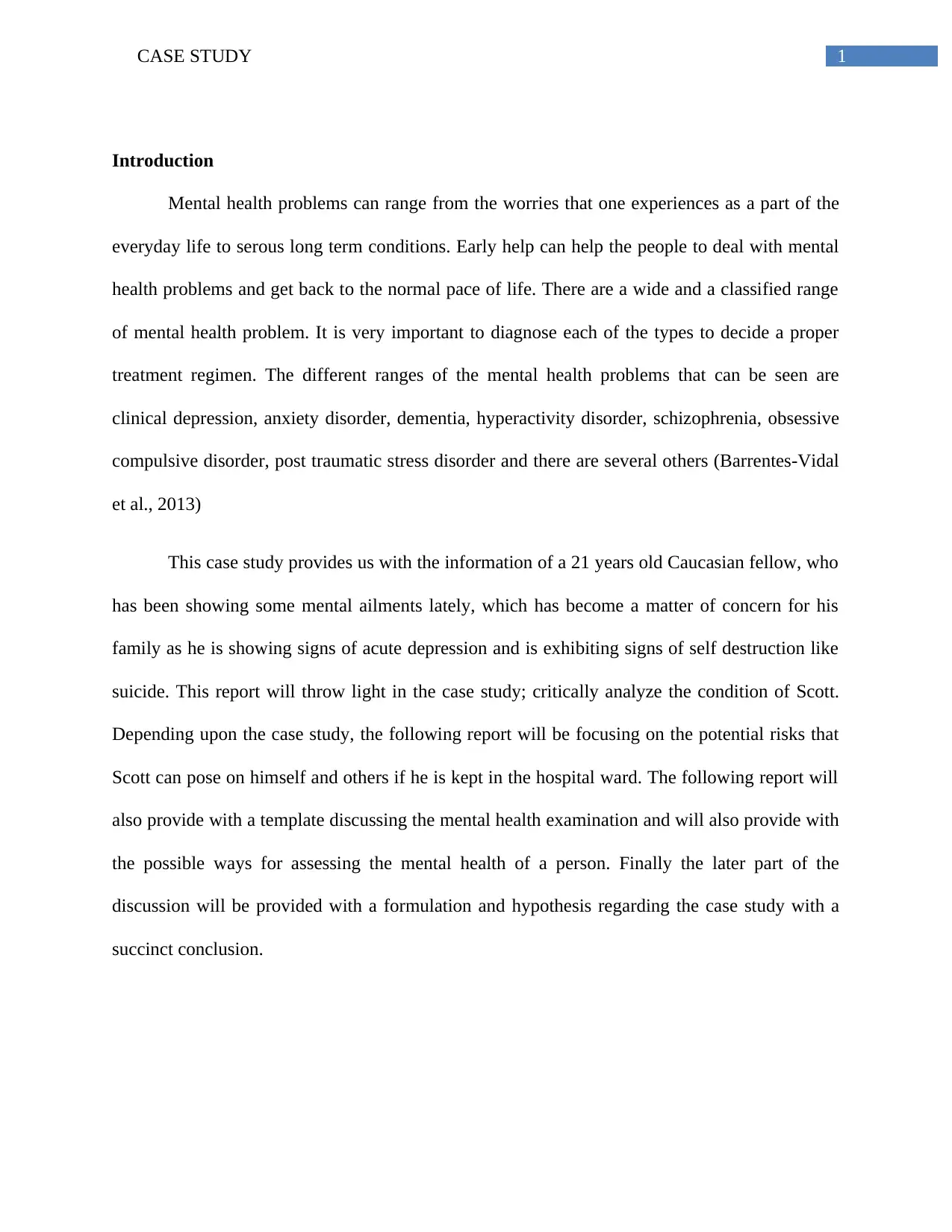
1CASE STUDY
Introduction
Mental health problems can range from the worries that one experiences as a part of the
everyday life to serous long term conditions. Early help can help the people to deal with mental
health problems and get back to the normal pace of life. There are a wide and a classified range
of mental health problem. It is very important to diagnose each of the types to decide a proper
treatment regimen. The different ranges of the mental health problems that can be seen are
clinical depression, anxiety disorder, dementia, hyperactivity disorder, schizophrenia, obsessive
compulsive disorder, post traumatic stress disorder and there are several others (Barrentes-Vidal
et al., 2013)
This case study provides us with the information of a 21 years old Caucasian fellow, who
has been showing some mental ailments lately, which has become a matter of concern for his
family as he is showing signs of acute depression and is exhibiting signs of self destruction like
suicide. This report will throw light in the case study; critically analyze the condition of Scott.
Depending upon the case study, the following report will be focusing on the potential risks that
Scott can pose on himself and others if he is kept in the hospital ward. The following report will
also provide with a template discussing the mental health examination and will also provide with
the possible ways for assessing the mental health of a person. Finally the later part of the
discussion will be provided with a formulation and hypothesis regarding the case study with a
succinct conclusion.
Introduction
Mental health problems can range from the worries that one experiences as a part of the
everyday life to serous long term conditions. Early help can help the people to deal with mental
health problems and get back to the normal pace of life. There are a wide and a classified range
of mental health problem. It is very important to diagnose each of the types to decide a proper
treatment regimen. The different ranges of the mental health problems that can be seen are
clinical depression, anxiety disorder, dementia, hyperactivity disorder, schizophrenia, obsessive
compulsive disorder, post traumatic stress disorder and there are several others (Barrentes-Vidal
et al., 2013)
This case study provides us with the information of a 21 years old Caucasian fellow, who
has been showing some mental ailments lately, which has become a matter of concern for his
family as he is showing signs of acute depression and is exhibiting signs of self destruction like
suicide. This report will throw light in the case study; critically analyze the condition of Scott.
Depending upon the case study, the following report will be focusing on the potential risks that
Scott can pose on himself and others if he is kept in the hospital ward. The following report will
also provide with a template discussing the mental health examination and will also provide with
the possible ways for assessing the mental health of a person. Finally the later part of the
discussion will be provided with a formulation and hypothesis regarding the case study with a
succinct conclusion.
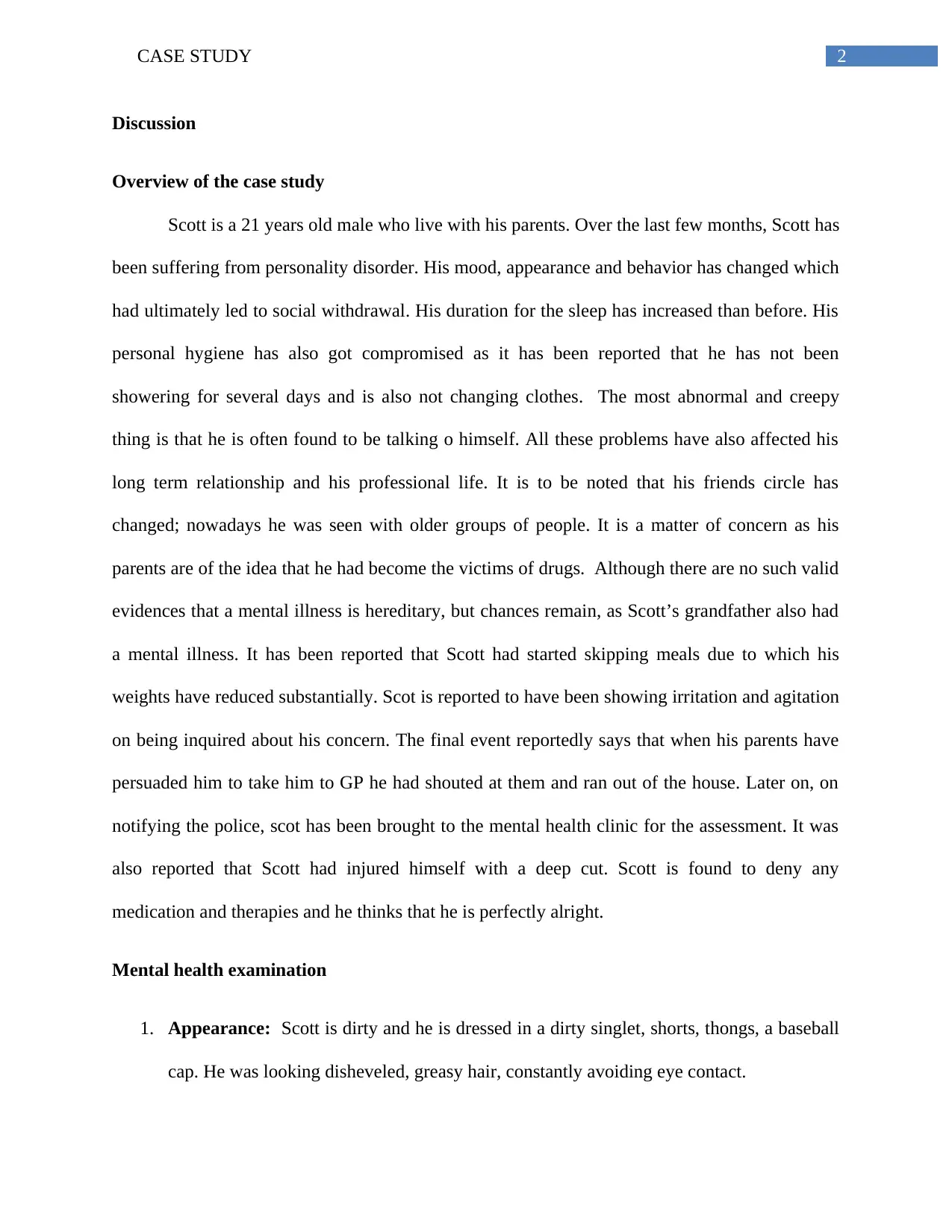
2CASE STUDY
Discussion
Overview of the case study
Scott is a 21 years old male who live with his parents. Over the last few months, Scott has
been suffering from personality disorder. His mood, appearance and behavior has changed which
had ultimately led to social withdrawal. His duration for the sleep has increased than before. His
personal hygiene has also got compromised as it has been reported that he has not been
showering for several days and is also not changing clothes. The most abnormal and creepy
thing is that he is often found to be talking o himself. All these problems have also affected his
long term relationship and his professional life. It is to be noted that his friends circle has
changed; nowadays he was seen with older groups of people. It is a matter of concern as his
parents are of the idea that he had become the victims of drugs. Although there are no such valid
evidences that a mental illness is hereditary, but chances remain, as Scott’s grandfather also had
a mental illness. It has been reported that Scott had started skipping meals due to which his
weights have reduced substantially. Scot is reported to have been showing irritation and agitation
on being inquired about his concern. The final event reportedly says that when his parents have
persuaded him to take him to GP he had shouted at them and ran out of the house. Later on, on
notifying the police, scot has been brought to the mental health clinic for the assessment. It was
also reported that Scott had injured himself with a deep cut. Scott is found to deny any
medication and therapies and he thinks that he is perfectly alright.
Mental health examination
1. Appearance: Scott is dirty and he is dressed in a dirty singlet, shorts, thongs, a baseball
cap. He was looking disheveled, greasy hair, constantly avoiding eye contact.
Discussion
Overview of the case study
Scott is a 21 years old male who live with his parents. Over the last few months, Scott has
been suffering from personality disorder. His mood, appearance and behavior has changed which
had ultimately led to social withdrawal. His duration for the sleep has increased than before. His
personal hygiene has also got compromised as it has been reported that he has not been
showering for several days and is also not changing clothes. The most abnormal and creepy
thing is that he is often found to be talking o himself. All these problems have also affected his
long term relationship and his professional life. It is to be noted that his friends circle has
changed; nowadays he was seen with older groups of people. It is a matter of concern as his
parents are of the idea that he had become the victims of drugs. Although there are no such valid
evidences that a mental illness is hereditary, but chances remain, as Scott’s grandfather also had
a mental illness. It has been reported that Scott had started skipping meals due to which his
weights have reduced substantially. Scot is reported to have been showing irritation and agitation
on being inquired about his concern. The final event reportedly says that when his parents have
persuaded him to take him to GP he had shouted at them and ran out of the house. Later on, on
notifying the police, scot has been brought to the mental health clinic for the assessment. It was
also reported that Scott had injured himself with a deep cut. Scott is found to deny any
medication and therapies and he thinks that he is perfectly alright.
Mental health examination
1. Appearance: Scott is dirty and he is dressed in a dirty singlet, shorts, thongs, a baseball
cap. He was looking disheveled, greasy hair, constantly avoiding eye contact.
⊘ This is a preview!⊘
Do you want full access?
Subscribe today to unlock all pages.

Trusted by 1+ million students worldwide
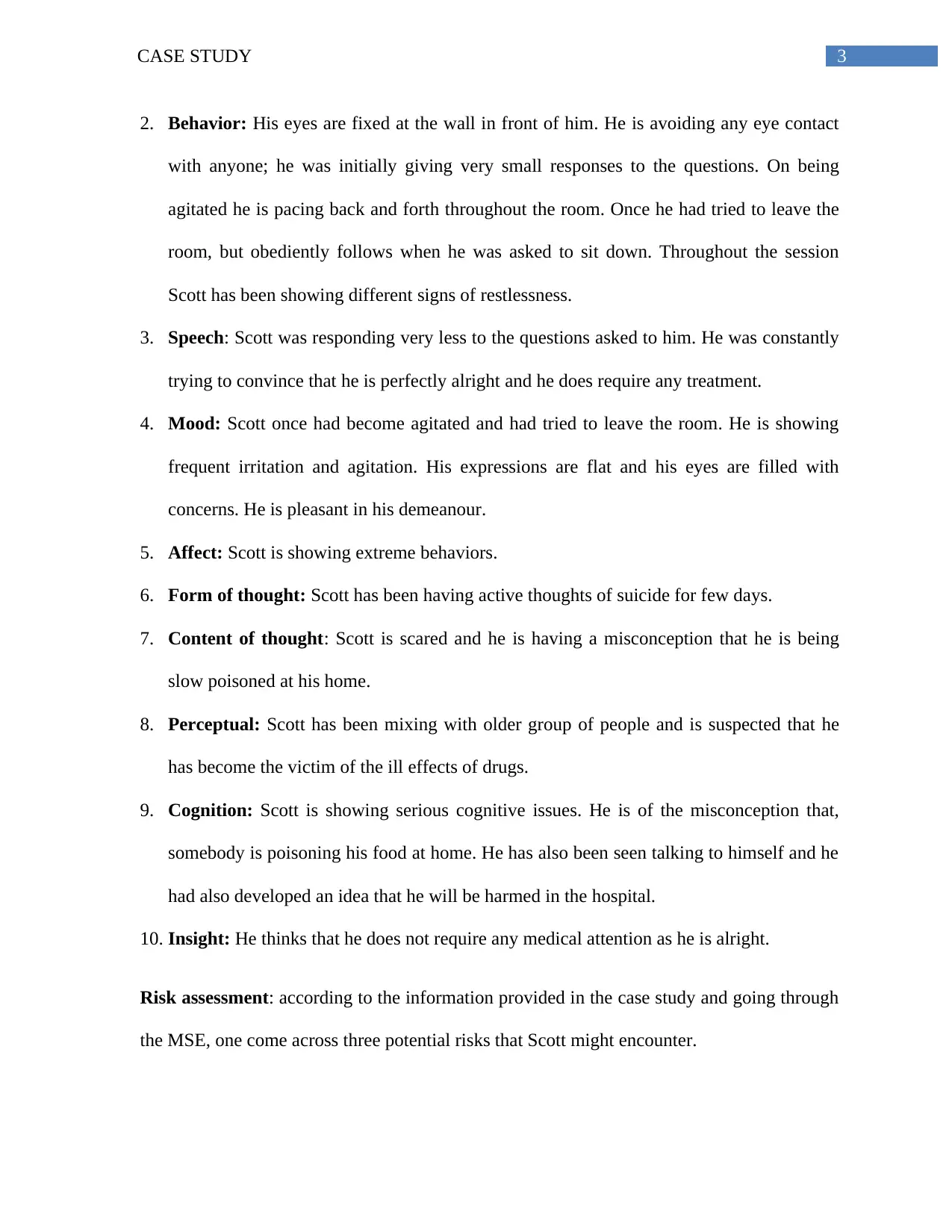
3CASE STUDY
2. Behavior: His eyes are fixed at the wall in front of him. He is avoiding any eye contact
with anyone; he was initially giving very small responses to the questions. On being
agitated he is pacing back and forth throughout the room. Once he had tried to leave the
room, but obediently follows when he was asked to sit down. Throughout the session
Scott has been showing different signs of restlessness.
3. Speech: Scott was responding very less to the questions asked to him. He was constantly
trying to convince that he is perfectly alright and he does require any treatment.
4. Mood: Scott once had become agitated and had tried to leave the room. He is showing
frequent irritation and agitation. His expressions are flat and his eyes are filled with
concerns. He is pleasant in his demeanour.
5. Affect: Scott is showing extreme behaviors.
6. Form of thought: Scott has been having active thoughts of suicide for few days.
7. Content of thought: Scott is scared and he is having a misconception that he is being
slow poisoned at his home.
8. Perceptual: Scott has been mixing with older group of people and is suspected that he
has become the victim of the ill effects of drugs.
9. Cognition: Scott is showing serious cognitive issues. He is of the misconception that,
somebody is poisoning his food at home. He has also been seen talking to himself and he
had also developed an idea that he will be harmed in the hospital.
10. Insight: He thinks that he does not require any medical attention as he is alright.
Risk assessment: according to the information provided in the case study and going through
the MSE, one come across three potential risks that Scott might encounter.
2. Behavior: His eyes are fixed at the wall in front of him. He is avoiding any eye contact
with anyone; he was initially giving very small responses to the questions. On being
agitated he is pacing back and forth throughout the room. Once he had tried to leave the
room, but obediently follows when he was asked to sit down. Throughout the session
Scott has been showing different signs of restlessness.
3. Speech: Scott was responding very less to the questions asked to him. He was constantly
trying to convince that he is perfectly alright and he does require any treatment.
4. Mood: Scott once had become agitated and had tried to leave the room. He is showing
frequent irritation and agitation. His expressions are flat and his eyes are filled with
concerns. He is pleasant in his demeanour.
5. Affect: Scott is showing extreme behaviors.
6. Form of thought: Scott has been having active thoughts of suicide for few days.
7. Content of thought: Scott is scared and he is having a misconception that he is being
slow poisoned at his home.
8. Perceptual: Scott has been mixing with older group of people and is suspected that he
has become the victim of the ill effects of drugs.
9. Cognition: Scott is showing serious cognitive issues. He is of the misconception that,
somebody is poisoning his food at home. He has also been seen talking to himself and he
had also developed an idea that he will be harmed in the hospital.
10. Insight: He thinks that he does not require any medical attention as he is alright.
Risk assessment: according to the information provided in the case study and going through
the MSE, one come across three potential risks that Scott might encounter.
Paraphrase This Document
Need a fresh take? Get an instant paraphrase of this document with our AI Paraphraser
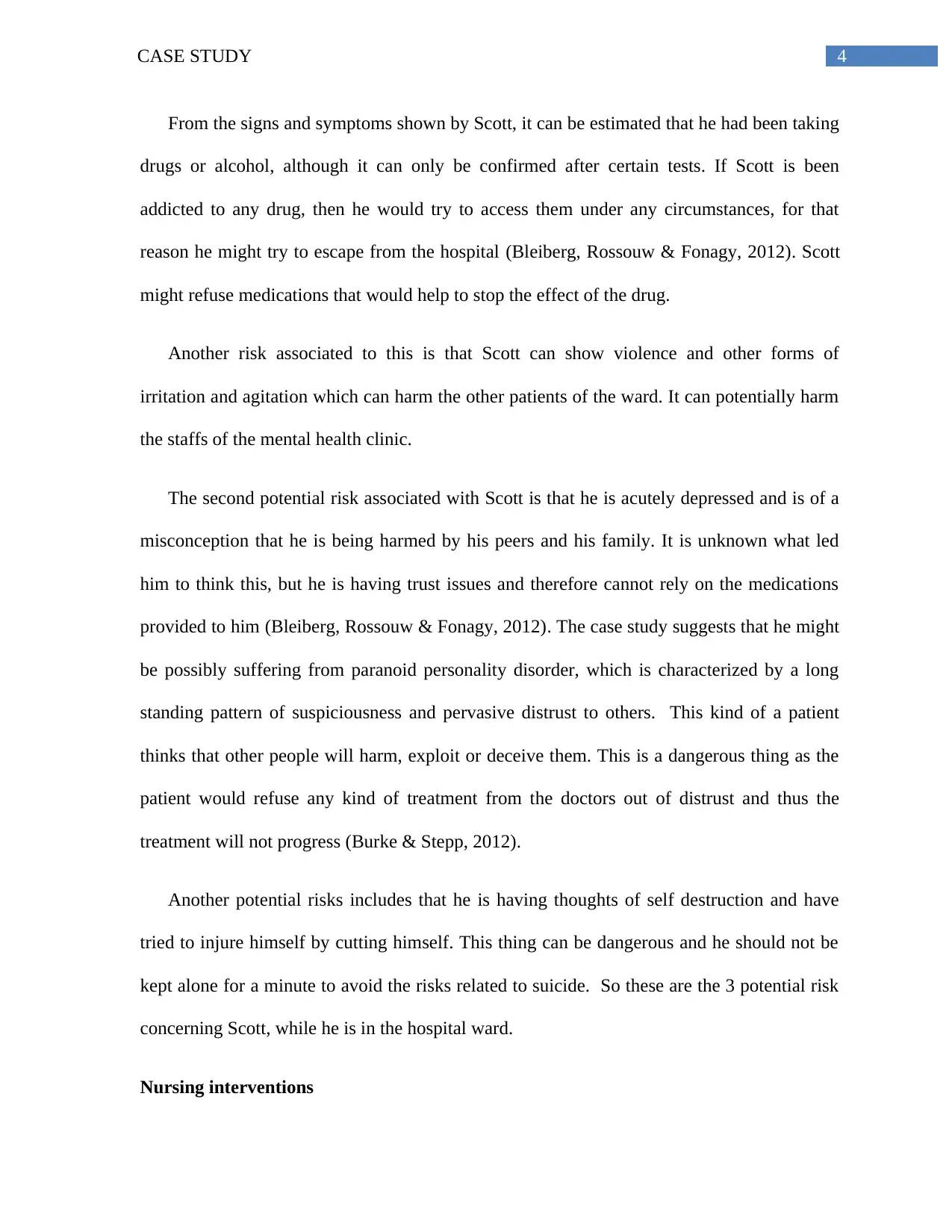
4CASE STUDY
From the signs and symptoms shown by Scott, it can be estimated that he had been taking
drugs or alcohol, although it can only be confirmed after certain tests. If Scott is been
addicted to any drug, then he would try to access them under any circumstances, for that
reason he might try to escape from the hospital (Bleiberg, Rossouw & Fonagy, 2012). Scott
might refuse medications that would help to stop the effect of the drug.
Another risk associated to this is that Scott can show violence and other forms of
irritation and agitation which can harm the other patients of the ward. It can potentially harm
the staffs of the mental health clinic.
The second potential risk associated with Scott is that he is acutely depressed and is of a
misconception that he is being harmed by his peers and his family. It is unknown what led
him to think this, but he is having trust issues and therefore cannot rely on the medications
provided to him (Bleiberg, Rossouw & Fonagy, 2012). The case study suggests that he might
be possibly suffering from paranoid personality disorder, which is characterized by a long
standing pattern of suspiciousness and pervasive distrust to others. This kind of a patient
thinks that other people will harm, exploit or deceive them. This is a dangerous thing as the
patient would refuse any kind of treatment from the doctors out of distrust and thus the
treatment will not progress (Burke & Stepp, 2012).
Another potential risks includes that he is having thoughts of self destruction and have
tried to injure himself by cutting himself. This thing can be dangerous and he should not be
kept alone for a minute to avoid the risks related to suicide. So these are the 3 potential risk
concerning Scott, while he is in the hospital ward.
Nursing interventions
From the signs and symptoms shown by Scott, it can be estimated that he had been taking
drugs or alcohol, although it can only be confirmed after certain tests. If Scott is been
addicted to any drug, then he would try to access them under any circumstances, for that
reason he might try to escape from the hospital (Bleiberg, Rossouw & Fonagy, 2012). Scott
might refuse medications that would help to stop the effect of the drug.
Another risk associated to this is that Scott can show violence and other forms of
irritation and agitation which can harm the other patients of the ward. It can potentially harm
the staffs of the mental health clinic.
The second potential risk associated with Scott is that he is acutely depressed and is of a
misconception that he is being harmed by his peers and his family. It is unknown what led
him to think this, but he is having trust issues and therefore cannot rely on the medications
provided to him (Bleiberg, Rossouw & Fonagy, 2012). The case study suggests that he might
be possibly suffering from paranoid personality disorder, which is characterized by a long
standing pattern of suspiciousness and pervasive distrust to others. This kind of a patient
thinks that other people will harm, exploit or deceive them. This is a dangerous thing as the
patient would refuse any kind of treatment from the doctors out of distrust and thus the
treatment will not progress (Burke & Stepp, 2012).
Another potential risks includes that he is having thoughts of self destruction and have
tried to injure himself by cutting himself. This thing can be dangerous and he should not be
kept alone for a minute to avoid the risks related to suicide. So these are the 3 potential risk
concerning Scott, while he is in the hospital ward.
Nursing interventions
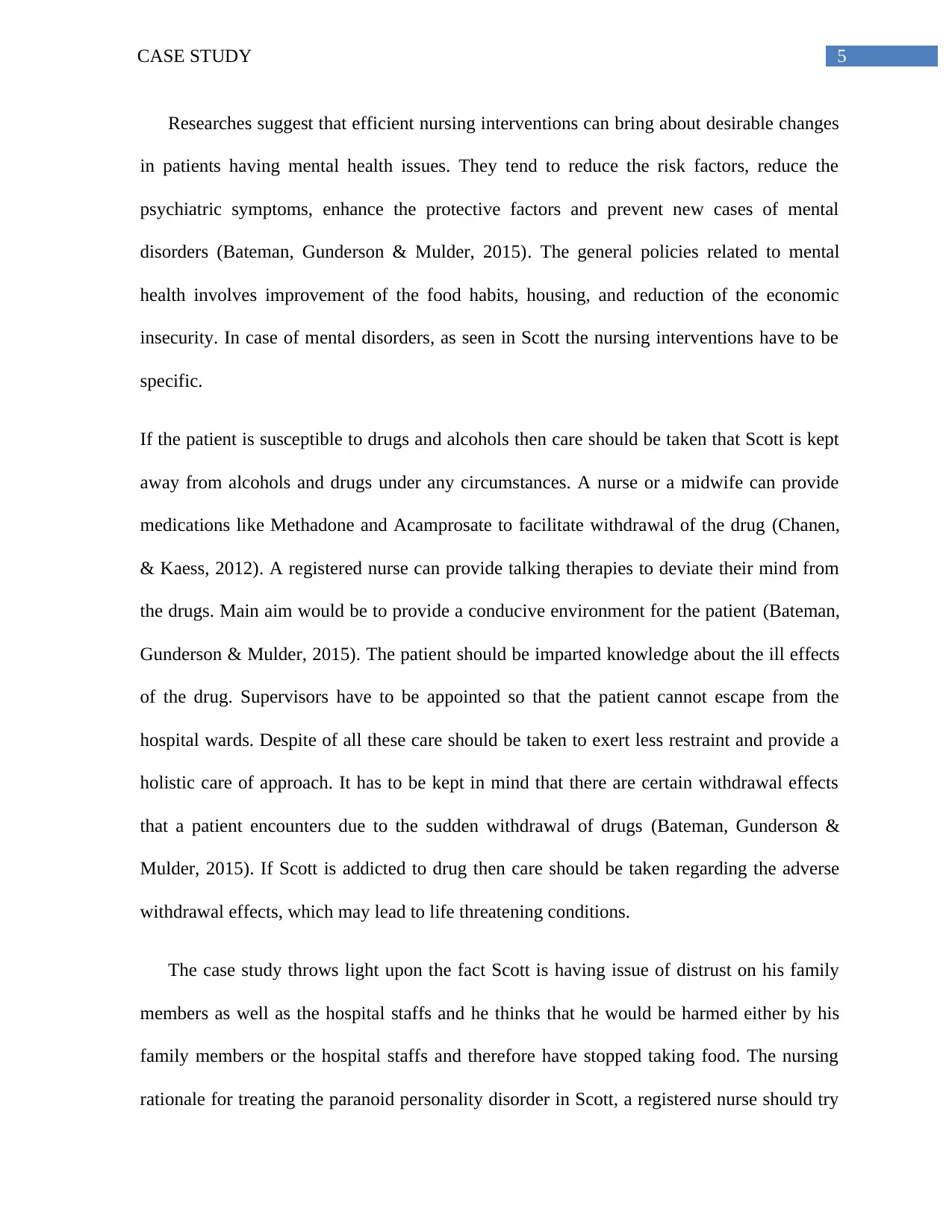
5CASE STUDY
Researches suggest that efficient nursing interventions can bring about desirable changes
in patients having mental health issues. They tend to reduce the risk factors, reduce the
psychiatric symptoms, enhance the protective factors and prevent new cases of mental
disorders (Bateman, Gunderson & Mulder, 2015). The general policies related to mental
health involves improvement of the food habits, housing, and reduction of the economic
insecurity. In case of mental disorders, as seen in Scott the nursing interventions have to be
specific.
If the patient is susceptible to drugs and alcohols then care should be taken that Scott is kept
away from alcohols and drugs under any circumstances. A nurse or a midwife can provide
medications like Methadone and Acamprosate to facilitate withdrawal of the drug (Chanen,
& Kaess, 2012). A registered nurse can provide talking therapies to deviate their mind from
the drugs. Main aim would be to provide a conducive environment for the patient (Bateman,
Gunderson & Mulder, 2015). The patient should be imparted knowledge about the ill effects
of the drug. Supervisors have to be appointed so that the patient cannot escape from the
hospital wards. Despite of all these care should be taken to exert less restraint and provide a
holistic care of approach. It has to be kept in mind that there are certain withdrawal effects
that a patient encounters due to the sudden withdrawal of drugs (Bateman, Gunderson &
Mulder, 2015). If Scott is addicted to drug then care should be taken regarding the adverse
withdrawal effects, which may lead to life threatening conditions.
The case study throws light upon the fact Scott is having issue of distrust on his family
members as well as the hospital staffs and he thinks that he would be harmed either by his
family members or the hospital staffs and therefore have stopped taking food. The nursing
rationale for treating the paranoid personality disorder in Scott, a registered nurse should try
Researches suggest that efficient nursing interventions can bring about desirable changes
in patients having mental health issues. They tend to reduce the risk factors, reduce the
psychiatric symptoms, enhance the protective factors and prevent new cases of mental
disorders (Bateman, Gunderson & Mulder, 2015). The general policies related to mental
health involves improvement of the food habits, housing, and reduction of the economic
insecurity. In case of mental disorders, as seen in Scott the nursing interventions have to be
specific.
If the patient is susceptible to drugs and alcohols then care should be taken that Scott is kept
away from alcohols and drugs under any circumstances. A nurse or a midwife can provide
medications like Methadone and Acamprosate to facilitate withdrawal of the drug (Chanen,
& Kaess, 2012). A registered nurse can provide talking therapies to deviate their mind from
the drugs. Main aim would be to provide a conducive environment for the patient (Bateman,
Gunderson & Mulder, 2015). The patient should be imparted knowledge about the ill effects
of the drug. Supervisors have to be appointed so that the patient cannot escape from the
hospital wards. Despite of all these care should be taken to exert less restraint and provide a
holistic care of approach. It has to be kept in mind that there are certain withdrawal effects
that a patient encounters due to the sudden withdrawal of drugs (Bateman, Gunderson &
Mulder, 2015). If Scott is addicted to drug then care should be taken regarding the adverse
withdrawal effects, which may lead to life threatening conditions.
The case study throws light upon the fact Scott is having issue of distrust on his family
members as well as the hospital staffs and he thinks that he would be harmed either by his
family members or the hospital staffs and therefore have stopped taking food. The nursing
rationale for treating the paranoid personality disorder in Scott, a registered nurse should try
⊘ This is a preview!⊘
Do you want full access?
Subscribe today to unlock all pages.

Trusted by 1+ million students worldwide
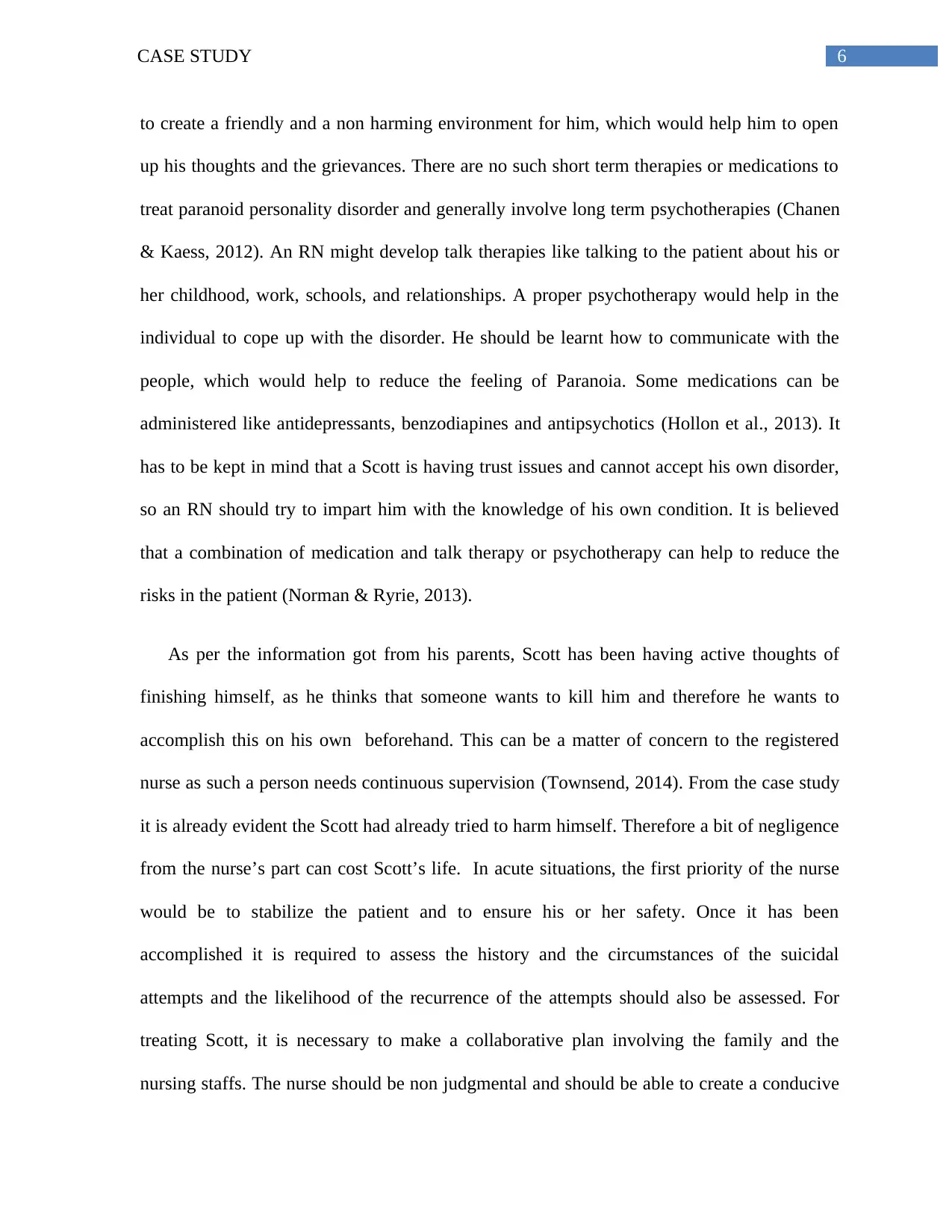
6CASE STUDY
to create a friendly and a non harming environment for him, which would help him to open
up his thoughts and the grievances. There are no such short term therapies or medications to
treat paranoid personality disorder and generally involve long term psychotherapies (Chanen
& Kaess, 2012). An RN might develop talk therapies like talking to the patient about his or
her childhood, work, schools, and relationships. A proper psychotherapy would help in the
individual to cope up with the disorder. He should be learnt how to communicate with the
people, which would help to reduce the feeling of Paranoia. Some medications can be
administered like antidepressants, benzodiapines and antipsychotics (Hollon et al., 2013). It
has to be kept in mind that a Scott is having trust issues and cannot accept his own disorder,
so an RN should try to impart him with the knowledge of his own condition. It is believed
that a combination of medication and talk therapy or psychotherapy can help to reduce the
risks in the patient (Norman & Ryrie, 2013).
As per the information got from his parents, Scott has been having active thoughts of
finishing himself, as he thinks that someone wants to kill him and therefore he wants to
accomplish this on his own beforehand. This can be a matter of concern to the registered
nurse as such a person needs continuous supervision (Townsend, 2014). From the case study
it is already evident the Scott had already tried to harm himself. Therefore a bit of negligence
from the nurse’s part can cost Scott’s life. In acute situations, the first priority of the nurse
would be to stabilize the patient and to ensure his or her safety. Once it has been
accomplished it is required to assess the history and the circumstances of the suicidal
attempts and the likelihood of the recurrence of the attempts should also be assessed. For
treating Scott, it is necessary to make a collaborative plan involving the family and the
nursing staffs. The nurse should be non judgmental and should be able to create a conducive
to create a friendly and a non harming environment for him, which would help him to open
up his thoughts and the grievances. There are no such short term therapies or medications to
treat paranoid personality disorder and generally involve long term psychotherapies (Chanen
& Kaess, 2012). An RN might develop talk therapies like talking to the patient about his or
her childhood, work, schools, and relationships. A proper psychotherapy would help in the
individual to cope up with the disorder. He should be learnt how to communicate with the
people, which would help to reduce the feeling of Paranoia. Some medications can be
administered like antidepressants, benzodiapines and antipsychotics (Hollon et al., 2013). It
has to be kept in mind that a Scott is having trust issues and cannot accept his own disorder,
so an RN should try to impart him with the knowledge of his own condition. It is believed
that a combination of medication and talk therapy or psychotherapy can help to reduce the
risks in the patient (Norman & Ryrie, 2013).
As per the information got from his parents, Scott has been having active thoughts of
finishing himself, as he thinks that someone wants to kill him and therefore he wants to
accomplish this on his own beforehand. This can be a matter of concern to the registered
nurse as such a person needs continuous supervision (Townsend, 2014). From the case study
it is already evident the Scott had already tried to harm himself. Therefore a bit of negligence
from the nurse’s part can cost Scott’s life. In acute situations, the first priority of the nurse
would be to stabilize the patient and to ensure his or her safety. Once it has been
accomplished it is required to assess the history and the circumstances of the suicidal
attempts and the likelihood of the recurrence of the attempts should also be assessed. For
treating Scott, it is necessary to make a collaborative plan involving the family and the
nursing staffs. The nurse should be non judgmental and should be able to create a conducive
Paraphrase This Document
Need a fresh take? Get an instant paraphrase of this document with our AI Paraphraser
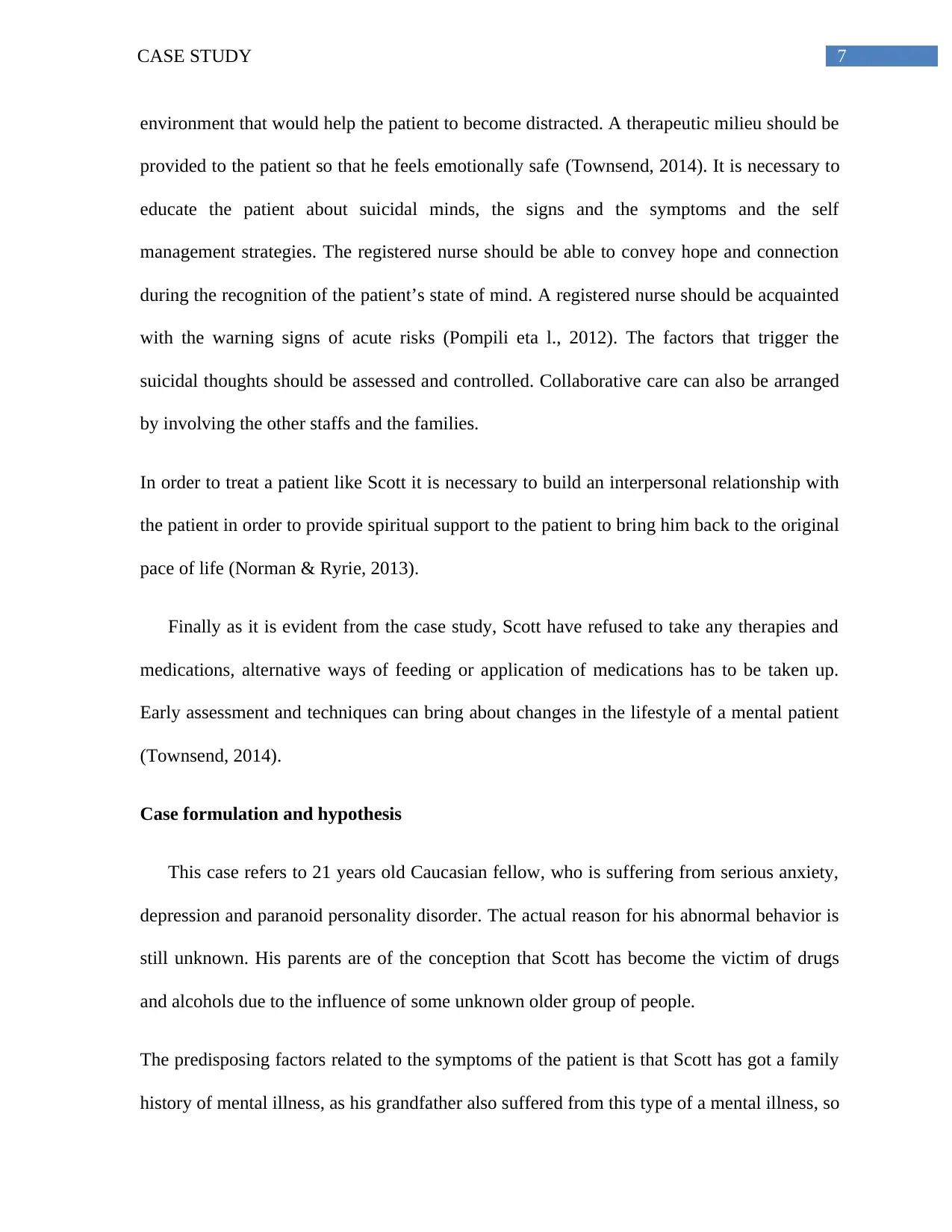
7CASE STUDY
environment that would help the patient to become distracted. A therapeutic milieu should be
provided to the patient so that he feels emotionally safe (Townsend, 2014). It is necessary to
educate the patient about suicidal minds, the signs and the symptoms and the self
management strategies. The registered nurse should be able to convey hope and connection
during the recognition of the patient’s state of mind. A registered nurse should be acquainted
with the warning signs of acute risks (Pompili eta l., 2012). The factors that trigger the
suicidal thoughts should be assessed and controlled. Collaborative care can also be arranged
by involving the other staffs and the families.
In order to treat a patient like Scott it is necessary to build an interpersonal relationship with
the patient in order to provide spiritual support to the patient to bring him back to the original
pace of life (Norman & Ryrie, 2013).
Finally as it is evident from the case study, Scott have refused to take any therapies and
medications, alternative ways of feeding or application of medications has to be taken up.
Early assessment and techniques can bring about changes in the lifestyle of a mental patient
(Townsend, 2014).
Case formulation and hypothesis
This case refers to 21 years old Caucasian fellow, who is suffering from serious anxiety,
depression and paranoid personality disorder. The actual reason for his abnormal behavior is
still unknown. His parents are of the conception that Scott has become the victim of drugs
and alcohols due to the influence of some unknown older group of people.
The predisposing factors related to the symptoms of the patient is that Scott has got a family
history of mental illness, as his grandfather also suffered from this type of a mental illness, so
environment that would help the patient to become distracted. A therapeutic milieu should be
provided to the patient so that he feels emotionally safe (Townsend, 2014). It is necessary to
educate the patient about suicidal minds, the signs and the symptoms and the self
management strategies. The registered nurse should be able to convey hope and connection
during the recognition of the patient’s state of mind. A registered nurse should be acquainted
with the warning signs of acute risks (Pompili eta l., 2012). The factors that trigger the
suicidal thoughts should be assessed and controlled. Collaborative care can also be arranged
by involving the other staffs and the families.
In order to treat a patient like Scott it is necessary to build an interpersonal relationship with
the patient in order to provide spiritual support to the patient to bring him back to the original
pace of life (Norman & Ryrie, 2013).
Finally as it is evident from the case study, Scott have refused to take any therapies and
medications, alternative ways of feeding or application of medications has to be taken up.
Early assessment and techniques can bring about changes in the lifestyle of a mental patient
(Townsend, 2014).
Case formulation and hypothesis
This case refers to 21 years old Caucasian fellow, who is suffering from serious anxiety,
depression and paranoid personality disorder. The actual reason for his abnormal behavior is
still unknown. His parents are of the conception that Scott has become the victim of drugs
and alcohols due to the influence of some unknown older group of people.
The predisposing factors related to the symptoms of the patient is that Scott has got a family
history of mental illness, as his grandfather also suffered from this type of a mental illness, so
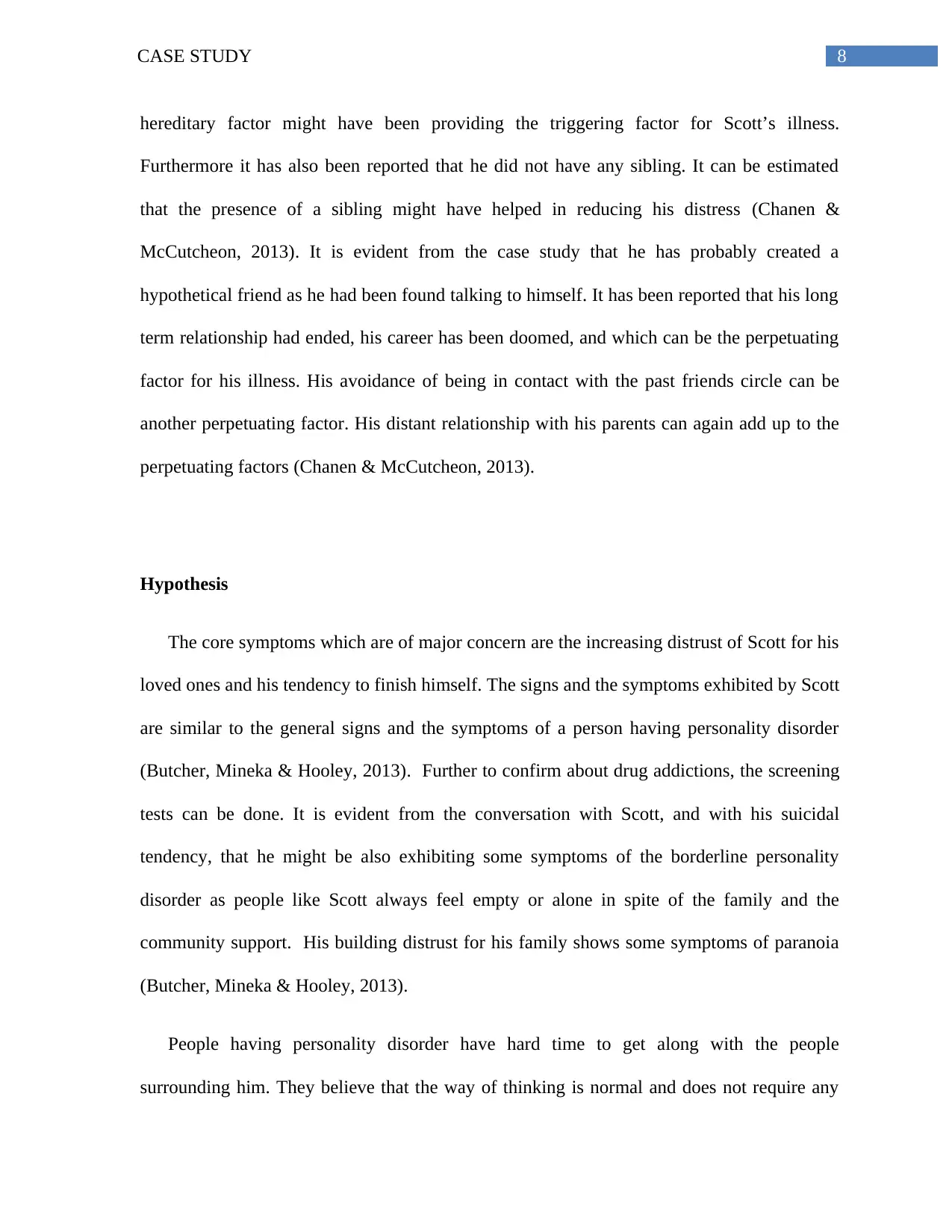
8CASE STUDY
hereditary factor might have been providing the triggering factor for Scott’s illness.
Furthermore it has also been reported that he did not have any sibling. It can be estimated
that the presence of a sibling might have helped in reducing his distress (Chanen &
McCutcheon, 2013). It is evident from the case study that he has probably created a
hypothetical friend as he had been found talking to himself. It has been reported that his long
term relationship had ended, his career has been doomed, and which can be the perpetuating
factor for his illness. His avoidance of being in contact with the past friends circle can be
another perpetuating factor. His distant relationship with his parents can again add up to the
perpetuating factors (Chanen & McCutcheon, 2013).
Hypothesis
The core symptoms which are of major concern are the increasing distrust of Scott for his
loved ones and his tendency to finish himself. The signs and the symptoms exhibited by Scott
are similar to the general signs and the symptoms of a person having personality disorder
(Butcher, Mineka & Hooley, 2013). Further to confirm about drug addictions, the screening
tests can be done. It is evident from the conversation with Scott, and with his suicidal
tendency, that he might be also exhibiting some symptoms of the borderline personality
disorder as people like Scott always feel empty or alone in spite of the family and the
community support. His building distrust for his family shows some symptoms of paranoia
(Butcher, Mineka & Hooley, 2013).
People having personality disorder have hard time to get along with the people
surrounding him. They believe that the way of thinking is normal and does not require any
hereditary factor might have been providing the triggering factor for Scott’s illness.
Furthermore it has also been reported that he did not have any sibling. It can be estimated
that the presence of a sibling might have helped in reducing his distress (Chanen &
McCutcheon, 2013). It is evident from the case study that he has probably created a
hypothetical friend as he had been found talking to himself. It has been reported that his long
term relationship had ended, his career has been doomed, and which can be the perpetuating
factor for his illness. His avoidance of being in contact with the past friends circle can be
another perpetuating factor. His distant relationship with his parents can again add up to the
perpetuating factors (Chanen & McCutcheon, 2013).
Hypothesis
The core symptoms which are of major concern are the increasing distrust of Scott for his
loved ones and his tendency to finish himself. The signs and the symptoms exhibited by Scott
are similar to the general signs and the symptoms of a person having personality disorder
(Butcher, Mineka & Hooley, 2013). Further to confirm about drug addictions, the screening
tests can be done. It is evident from the conversation with Scott, and with his suicidal
tendency, that he might be also exhibiting some symptoms of the borderline personality
disorder as people like Scott always feel empty or alone in spite of the family and the
community support. His building distrust for his family shows some symptoms of paranoia
(Butcher, Mineka & Hooley, 2013).
People having personality disorder have hard time to get along with the people
surrounding him. They believe that the way of thinking is normal and does not require any
⊘ This is a preview!⊘
Do you want full access?
Subscribe today to unlock all pages.

Trusted by 1+ million students worldwide
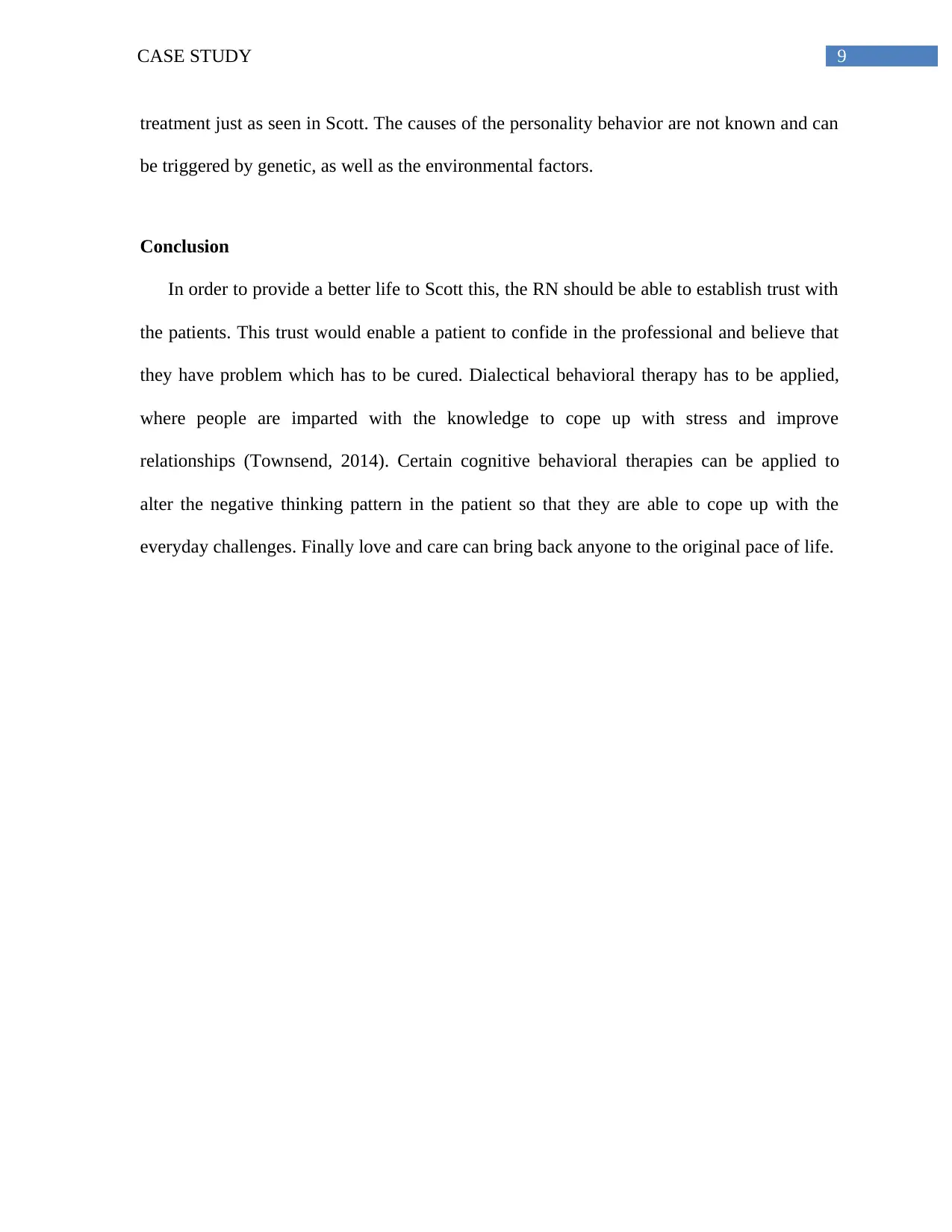
9CASE STUDY
treatment just as seen in Scott. The causes of the personality behavior are not known and can
be triggered by genetic, as well as the environmental factors.
Conclusion
In order to provide a better life to Scott this, the RN should be able to establish trust with
the patients. This trust would enable a patient to confide in the professional and believe that
they have problem which has to be cured. Dialectical behavioral therapy has to be applied,
where people are imparted with the knowledge to cope up with stress and improve
relationships (Townsend, 2014). Certain cognitive behavioral therapies can be applied to
alter the negative thinking pattern in the patient so that they are able to cope up with the
everyday challenges. Finally love and care can bring back anyone to the original pace of life.
treatment just as seen in Scott. The causes of the personality behavior are not known and can
be triggered by genetic, as well as the environmental factors.
Conclusion
In order to provide a better life to Scott this, the RN should be able to establish trust with
the patients. This trust would enable a patient to confide in the professional and believe that
they have problem which has to be cured. Dialectical behavioral therapy has to be applied,
where people are imparted with the knowledge to cope up with stress and improve
relationships (Townsend, 2014). Certain cognitive behavioral therapies can be applied to
alter the negative thinking pattern in the patient so that they are able to cope up with the
everyday challenges. Finally love and care can bring back anyone to the original pace of life.
Paraphrase This Document
Need a fresh take? Get an instant paraphrase of this document with our AI Paraphraser
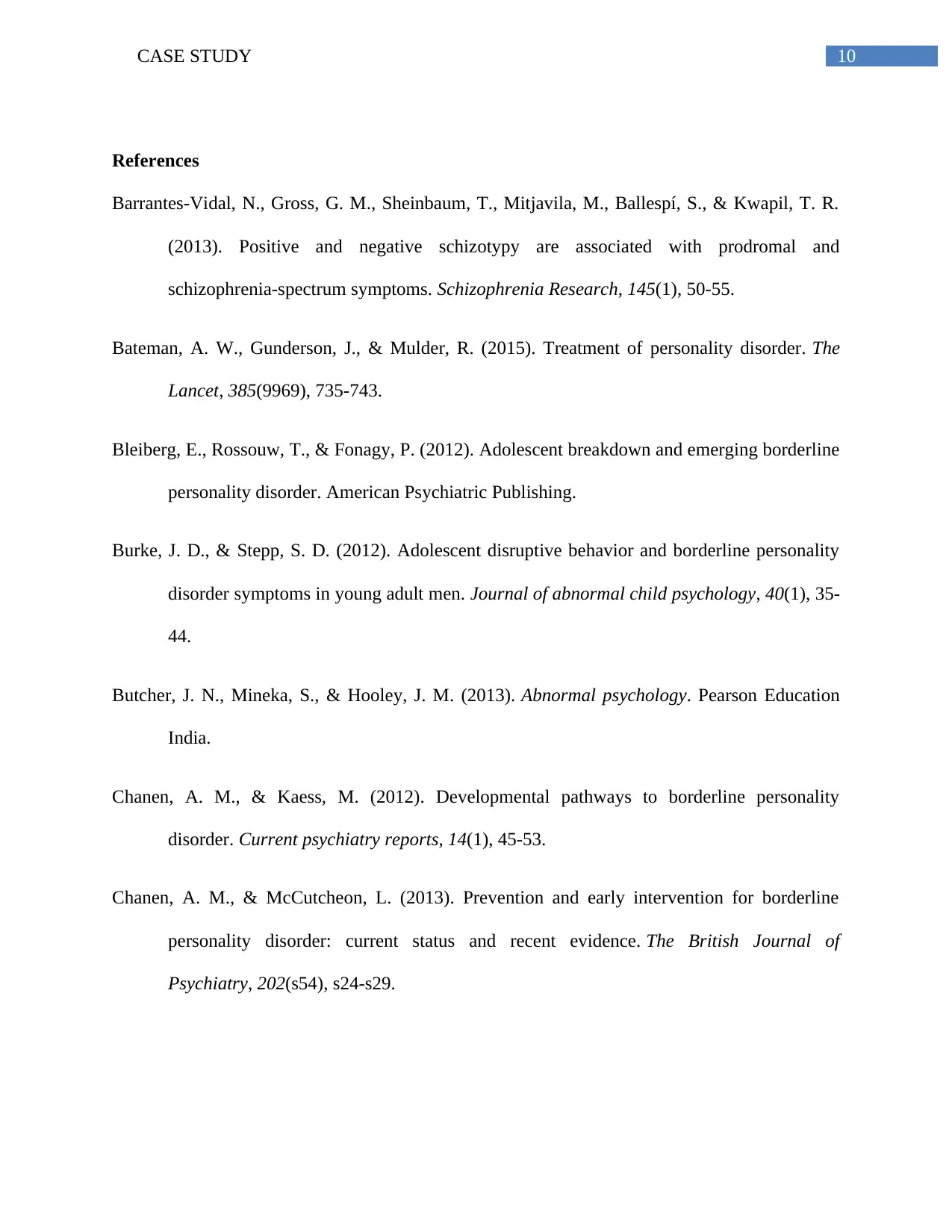
10CASE STUDY
References
Barrantes-Vidal, N., Gross, G. M., Sheinbaum, T., Mitjavila, M., Ballespí, S., & Kwapil, T. R.
(2013). Positive and negative schizotypy are associated with prodromal and
schizophrenia-spectrum symptoms. Schizophrenia Research, 145(1), 50-55.
Bateman, A. W., Gunderson, J., & Mulder, R. (2015). Treatment of personality disorder. The
Lancet, 385(9969), 735-743.
Bleiberg, E., Rossouw, T., & Fonagy, P. (2012). Adolescent breakdown and emerging borderline
personality disorder. American Psychiatric Publishing.
Burke, J. D., & Stepp, S. D. (2012). Adolescent disruptive behavior and borderline personality
disorder symptoms in young adult men. Journal of abnormal child psychology, 40(1), 35-
44.
Butcher, J. N., Mineka, S., & Hooley, J. M. (2013). Abnormal psychology. Pearson Education
India.
Chanen, A. M., & Kaess, M. (2012). Developmental pathways to borderline personality
disorder. Current psychiatry reports, 14(1), 45-53.
Chanen, A. M., & McCutcheon, L. (2013). Prevention and early intervention for borderline
personality disorder: current status and recent evidence. The British Journal of
Psychiatry, 202(s54), s24-s29.
References
Barrantes-Vidal, N., Gross, G. M., Sheinbaum, T., Mitjavila, M., Ballespí, S., & Kwapil, T. R.
(2013). Positive and negative schizotypy are associated with prodromal and
schizophrenia-spectrum symptoms. Schizophrenia Research, 145(1), 50-55.
Bateman, A. W., Gunderson, J., & Mulder, R. (2015). Treatment of personality disorder. The
Lancet, 385(9969), 735-743.
Bleiberg, E., Rossouw, T., & Fonagy, P. (2012). Adolescent breakdown and emerging borderline
personality disorder. American Psychiatric Publishing.
Burke, J. D., & Stepp, S. D. (2012). Adolescent disruptive behavior and borderline personality
disorder symptoms in young adult men. Journal of abnormal child psychology, 40(1), 35-
44.
Butcher, J. N., Mineka, S., & Hooley, J. M. (2013). Abnormal psychology. Pearson Education
India.
Chanen, A. M., & Kaess, M. (2012). Developmental pathways to borderline personality
disorder. Current psychiatry reports, 14(1), 45-53.
Chanen, A. M., & McCutcheon, L. (2013). Prevention and early intervention for borderline
personality disorder: current status and recent evidence. The British Journal of
Psychiatry, 202(s54), s24-s29.
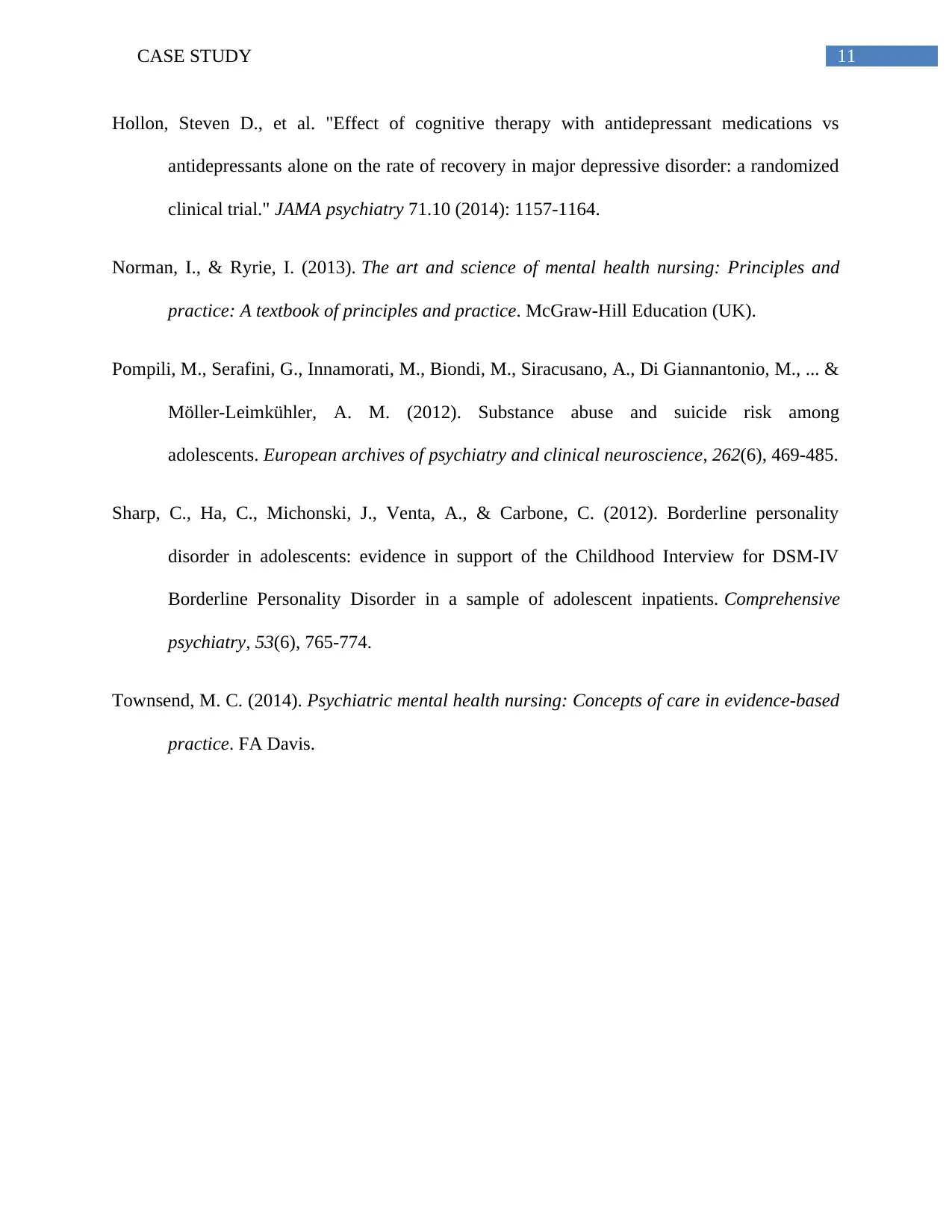
11CASE STUDY
Hollon, Steven D., et al. "Effect of cognitive therapy with antidepressant medications vs
antidepressants alone on the rate of recovery in major depressive disorder: a randomized
clinical trial." JAMA psychiatry 71.10 (2014): 1157-1164.
Norman, I., & Ryrie, I. (2013). The art and science of mental health nursing: Principles and
practice: A textbook of principles and practice. McGraw-Hill Education (UK).
Pompili, M., Serafini, G., Innamorati, M., Biondi, M., Siracusano, A., Di Giannantonio, M., ... &
Möller-Leimkühler, A. M. (2012). Substance abuse and suicide risk among
adolescents. European archives of psychiatry and clinical neuroscience, 262(6), 469-485.
Sharp, C., Ha, C., Michonski, J., Venta, A., & Carbone, C. (2012). Borderline personality
disorder in adolescents: evidence in support of the Childhood Interview for DSM-IV
Borderline Personality Disorder in a sample of adolescent inpatients. Comprehensive
psychiatry, 53(6), 765-774.
Townsend, M. C. (2014). Psychiatric mental health nursing: Concepts of care in evidence-based
practice. FA Davis.
Hollon, Steven D., et al. "Effect of cognitive therapy with antidepressant medications vs
antidepressants alone on the rate of recovery in major depressive disorder: a randomized
clinical trial." JAMA psychiatry 71.10 (2014): 1157-1164.
Norman, I., & Ryrie, I. (2013). The art and science of mental health nursing: Principles and
practice: A textbook of principles and practice. McGraw-Hill Education (UK).
Pompili, M., Serafini, G., Innamorati, M., Biondi, M., Siracusano, A., Di Giannantonio, M., ... &
Möller-Leimkühler, A. M. (2012). Substance abuse and suicide risk among
adolescents. European archives of psychiatry and clinical neuroscience, 262(6), 469-485.
Sharp, C., Ha, C., Michonski, J., Venta, A., & Carbone, C. (2012). Borderline personality
disorder in adolescents: evidence in support of the Childhood Interview for DSM-IV
Borderline Personality Disorder in a sample of adolescent inpatients. Comprehensive
psychiatry, 53(6), 765-774.
Townsend, M. C. (2014). Psychiatric mental health nursing: Concepts of care in evidence-based
practice. FA Davis.
⊘ This is a preview!⊘
Do you want full access?
Subscribe today to unlock all pages.

Trusted by 1+ million students worldwide
1 out of 14
Related Documents
Your All-in-One AI-Powered Toolkit for Academic Success.
+13062052269
info@desklib.com
Available 24*7 on WhatsApp / Email
![[object Object]](/_next/static/media/star-bottom.7253800d.svg)
Unlock your academic potential
Copyright © 2020–2025 A2Z Services. All Rights Reserved. Developed and managed by ZUCOL.





